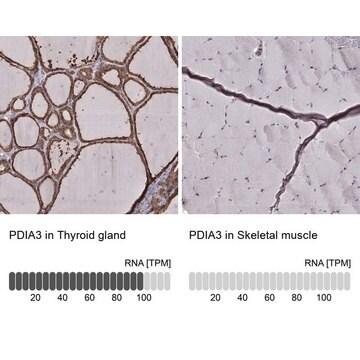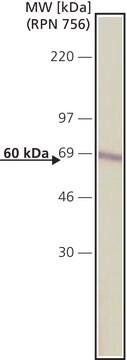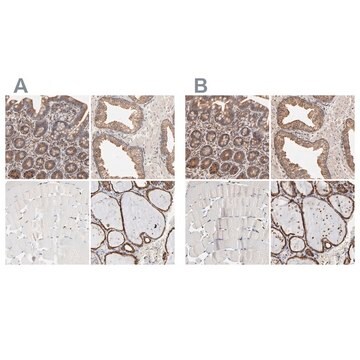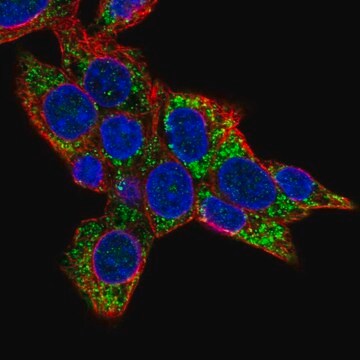推荐产品
生物源
rabbit
共軛
unconjugated
抗體表格
affinity isolated antibody
抗體產品種類
primary antibodies
無性繁殖
polyclonal
產品線
Prestige Antibodies® Powered by Atlas Antibodies
形狀
buffered aqueous glycerol solution
物種活性
human
技術
immunofluorescence: 0.25-2 μg/mL
免疫原序列
GDYGFGVLVQSNTGNKSAFPVRFHPHLQPPHHHQNATPSPAAFINNNTAANGSSA
UniProt登錄號
運輸包裝
wet ice
儲存溫度
−20°C
目標翻譯後修改
unmodified
基因資訊
human ... CPEB4(80315)
一般說明
The gene CPEB4 (cytoplasmic polyadenylation element binding protein 4) is mapped to human chromosome 5q35.2. It belongs to the CPEB family of proteins. CPEB4 is an RNA binding protein.
免疫原
cytoplasmic polyadenylation element binding protein 4 recombinant protein epitope signature tag (PrEST)
應用
All Prestige Antibodies®Powered by Atlas Antibodies is developed and validated by the Human Protein Atlas (HPA) project . Each antibody is tested by immunohistochemistry against hundreds of normal and disease tissues. These images can be viewed on the Human Protein Atlas (HPA) site by clicking on the Image Gallery link. We also provide Prestige Antibodies® protocols and other useful information.
Anti-CPEB4 antibody produced in rabbit has been used in western blotting and immunohistochemistry.
Anti-CPEB4 antibody produced in rabbit has been used in western blotting and immunohistochemistry.
生化/生理作用
CPEB4 (cytoplasmic polyadenylation element binding protein 4) is mainly responsible for polyadenylation and translational activation of mRNAs containing CPE (cytoplasmic polyadenylation element). It is also associated with tumor growth, migration, vascularization, invasion and metastasis. The protein works as a transcriptional regulator in tumor development.
特點和優勢
Prestige Antibodies® are highly characterized and extensively validated antibodies with the added benefit of all available characterization data for each target being accessible via the Human Protein Atlas portal linked just below the product name at the top of this page. The uniqueness and low cross-reactivity of the Prestige Antibodies® to other proteins are due to a thorough selection of antigen regions, affinity purification, and stringent selection. Prestige antigen controls are available for every corresponding Prestige Antibody and can be found in the linkage section.
Every Prestige Antibody is tested in the following ways:
Every Prestige Antibody is tested in the following ways:
- IHC tissue array of 44 normal human tissues and 20 of the most common cancer type tissues.
- Protein array of 364 human recombinant protein fragments.
聯結
Corresponding Antigen APREST79986
外觀
Solution in phosphate buffered saline, pH 7.2, containing 40% glycerol and 0.02% sodium azide.
法律資訊
Prestige Antibodies is a registered trademark of Merck KGaA, Darmstadt, Germany
免責聲明
Unless otherwise stated in our catalog or other company documentation accompanying the product(s), our products are intended for research use only and are not to be used for any other purpose, which includes but is not limited to, unauthorized commercial uses, in vitro diagnostic uses, ex vivo or in vivo therapeutic uses or any type of consumption or application to humans or animals.
Not finding the right product?
Try our 产品选型工具.
儲存類別代碼
10 - Combustible liquids
水污染物質分類(WGK)
WGK 1
Li-Yun Tsai et al.
PloS one, 11(5), e0155025-e0155025 (2016-05-10)
Cytoplasmic polyadenylation element binding protein 4 (CPEB4) is a sequence-specific RNA-binding protein and translational regulator, with expression associated with tumor progression. Nevertheless, CPEB4 seems to play paradoxical roles in cancers-an oncogenic promoter in pancreatic ductal adenocarcinoma (PDA) and glioblastomas but
Somatic CPEB4 and CPEB1 genes mutations spectrum on the prognostic predictive accuracy in patients with high-grade glioma and their clinical significance.
Boustani MR, et al.
Journal of the Neurological Sciences, 363, 80-83 (2016)
Sequential Functions of CPEB1 and CPEB4 Regulate Pathologic Expression of Vascular Endothelial Growth Factor and Angiogenesis in Chronic Liver Disease.
Calderone V, et al.
Gastroenterology, 982-997 (2016)
Manli Zeng et al.
Oncology letters, 15(3), 3226-3232 (2018-02-13)
Cytoplasmic polyadenylation element-binding protein-4 (CPEB4) is involved in several biological processes that are associated with cancer progression. However, it remains unknown whether CPEB4 expression levels are associated with head and neck squamous cell carcinoma (HNSCC). The aim of the present
Sara Picó et al.
Science translational medicine, 13(613), eabe7104-eabe7104 (2021-09-30)
Huntington’s disease (HD) is a hereditary neurodegenerative disorder of the basal ganglia for which disease-modifying treatments are not yet available. Although gene-silencing therapies are currently being tested, further molecular mechanisms must be explored to identify druggable targets for HD. Cytoplasmic
我们的科学家团队拥有各种研究领域经验,包括生命科学、材料科学、化学合成、色谱、分析及许多其他领域.
联系技术服务部门








